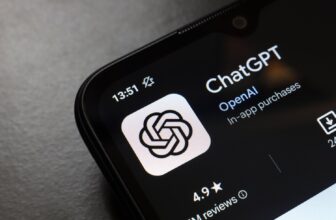This text was initially printed on The Conversation.
American technologists have been telling educators to quickly undertake their new innovations for over a century. In 1922, Thomas Edison declared that within the close to future, all college textbooks would get replaced by movie strips, as a result of textual content was 2% environment friendly, however movie was 100% environment friendly. These bogus statistics are an excellent reminder that folks could be sensible technologists, whereas additionally being inept schooling reformers.
I consider Edison at any time when I hear technologists insisting that educators should undertake synthetic intelligence as quickly as doable to get forward of the transformation that’s about to scrub over faculties and society.
At MIT, I study the history and future of education technology, and I’ve by no means encountered an instance of a faculty system – a rustic, state or municipality – that quickly adopted a brand new digital know-how and noticed sturdy advantages for his or her college students. The primary districts to encourage college students to deliver cell phones to class didn’t higher put together youth for the long run than faculties that took a extra cautious strategy. There is no such thing as a proof that the primary nations to attach their lecture rooms to the web stand aside in financial development, instructional attainment or citizen well-being.
New schooling applied sciences are solely as highly effective because the communities that information their use. Opening a brand new browser tab is simple; creating the circumstances for good studying is tough.
It takes years for educators to develop new practices and norms, for college kids to undertake new routines, and for households to determine new assist mechanisms to ensure that a novel invention to reliably enhance studying. However as AI spreads by way of faculties, each historic evaluation and new analysis performed with Okay-12 academics and college students supply some steerage on navigating uncertainties and minimizing hurt.
We’ve been incorrect and overconfident earlier than
I began instructing highschool historical past college students to go looking the online in 2003. On the time, consultants in library and data science developed a pedagogy for internet analysis that inspired college students to intently learn web sites searching for markers of credibility: citations, correct formatting, and an “about” web page. We gave college students checklists like the CRAAP test – forex, reliability, authority, accuracy and goal – to information their analysis. We taught college students to keep away from Wikipedia and to belief web sites with .org or .edu domains over .com domains. All of it appeared affordable and evidence-informed on the time.
The primary peer-reviewed article demonstrating efficient strategies for instructing college students how to search the web was published in 2019. It confirmed that novices who used these generally taught methods carried out miserably in checks evaluating their capability to kind fact from fiction on the net. It additionally confirmed that consultants in on-line info analysis used a totally completely different strategy: shortly leaving a web page to see how different sources characterize it. That methodology, now referred to as lateral reading, resulted in quicker, extra correct looking. The work was a intestine punch for an previous trainer like me. We’d spent almost 20 years instructing thousands and thousands of scholars demonstrably ineffective methods of looking.
At this time, there’s a cottage trade of consultants, keynoters and “thought leaders” touring the nation purporting to coach educators on methods to use AI in faculties. Nationwide and worldwide organizations publish AI literacy frameworks claiming to know what expertise college students want for his or her future. Technologists invent apps that encourage academics and college students to make use of generative AI as tutors, as lesson planners, as writing editors, or as dialog companions. These approaches have about as a lot evidential assist at this time because the CRAAP check did when it was invented.
There’s a higher strategy than making overconfident guesses: rigorously testing new practices and methods and solely broadly advocating for those which have sturdy proof of effectiveness. As with internet literacy, that proof will take a decade or extra to emerge.
However there’s a distinction this time. AI is what I’ve referred to as an “arrival technology.” AI will not be invited into faculties by way of a technique of adoption, like shopping for a desktop pc or smartboard – it crashes the celebration after which begins rearranging the furnishings. Which means faculties should do one thing. Academics really feel this urgently. But in addition they want assist: Over the previous two years, my workforce has interviewed almost 100 educators from across the U.S., and one widespread chorus is “don’t make us go it alone.”
3 methods for prudent path ahead
Whereas ready for higher solutions from the schooling science neighborhood, which is able to take years, academics must be scientists themselves. I like to recommend three guideposts for transferring ahead with AI below circumstances of uncertainty: humility, experimentation and evaluation.
First, frequently remind college students and academics that something faculties attempt – literacy frameworks, instructing practices, new assessments – is a best guess. In 4 years, college students would possibly hear that what they had been first taught about utilizing AI has since proved to be fairly incorrect. All of us must be able to revise our considering.
Second, faculties want to look at their college students and curriculum, and determine what sorts of experiments they’d wish to conduct with AI. Some components of your curriculum would possibly invite playfulness and daring new efforts, whereas others deserve extra warning.
In our podcast “The Homework Machine,” we interviewed Eric Timmons, a trainer in Santa Ana, California, who teaches elective filmmaking programs. His college students’ ultimate assessments are advanced films that require a number of technical and inventive expertise to supply. An AI fanatic, Timmons makes use of AI to develop his curriculum, and he encourages college students to make use of AI instruments to resolve filmmaking issues, from scripting to technical design. He’s not anxious about AI doing all the pieces for college kids: As he says, “My college students like to make films. … So why would they exchange that with AI?”
It’s among the many finest, most considerate examples of an “all in” strategy that I’ve encountered. I can also’t think about recommending an analogous strategy for a course like ninth grade English, the place the pivotal introduction to secondary college writing most likely ought to be handled with extra cautious approaches.
Third, when academics do launch new experiments, they need to acknowledge that native evaluation will occur a lot quicker than rigorous science. Each time faculties launch a brand new AI coverage or instructing follow, educators ought to gather a pile of associated pupil work that was developed earlier than AI was used throughout instructing. For those who let college students use AI instruments for formative suggestions on science labs, seize a pile of circa-2022 lab experiences. Then, gather the brand new lab experiences. Overview whether or not the post-AI lab experiences show an improvement on the outcomes you care about, and revise practices accordingly.
Between native educators and the worldwide neighborhood of schooling scientists, individuals will study lots by 2035 about AI in faculties. We’d discover that AI is like the online, a spot with some dangers however finally so filled with essential, helpful assets that we proceed to ask it into faculties. Or we’d discover that AI is like cellphones, and the unfavourable results on well-being and learning finally outweigh the potential positive aspects, and thus are best treated with more aggressive restrictions.
Everybody in schooling feels an urgency to resolve the uncertainty round generative AI. However we don’t want a race to generate solutions first – we want a race to be proper.
Justin Reich, Professor of Digital Media, Massachusetts Institute of Technology (MIT)
This text is republished from The Conversation below a Inventive Commons license. Learn the original article.
Trending Merchandise

SAMSUNG FT45 Sequence 24-Inch FHD 1...

ASUS RT-AX1800S Dual Band WiFi 6 Ex...












